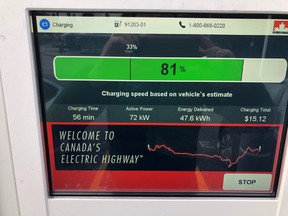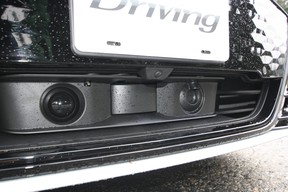Apart from a bit of a frunk up, this sport sedan fulfills the vision of a performance EV

Article content
Well, that was quite a ride. Just over 10 months of living with the Audi e-tron GT has certainly demonstrated the strengths of going electric. Of course, it didn’t hurt that since last fall fuel prices have nearly doubled across the country.
Advertisement 2
Article content
But the long-term test revealed there are many more benefits to driving an EV than the cost of operation. And, as an unusually snowy December underscored, there are also a pitfall, albeit minor, with this technological wundercar.

Let’s begin with that chilly tale. While not out of the ordinary to have snow in North Vancouver, we were hammered with not just volume but also for weeks on end. The Audi e-tron GT was not outfitted with all-seasons so it sat idle in the driveway for nearly four weeks before the snow had receded off the roads and the car itself. What really interested me was to see if the lithium-ion battery pack had lost any juice sitting for so long in sub-zero temperatures. Jumping in the driver’s seat I pressed the start button and…nothing. No power. Could the charge that was in the vehicle when it last drove have been totally depleted by sitting in the cold for a month? I plugged the charge cord into the charger in my driveway, waited about 30 minutes, hopped back in and pressed the start button. Nothing. So, by deduction I reasoned it was not the big battery pack that was dead but the garden variety 12-volt battery under the hood that had been drained. Not unlike how a gas-powered vehicle’s battery will go dead after sitting in the cold too long.
Advertisement 3
Article content
Problem solved, or so I thought. The next problem, and as it would turn out a big one, was without any power I could not open the frunk as the only way to open it was with the electric-operated button on the door frame. No manual release lever in the driver-side foot well and no latches under the frunk lid. So, I consulted the owner’s manual, found the section dealing with manual opening of the frunk. It read, “contact an authorized Audi dealer or authorized Audi Service Facility.”
Instead, I emailed my Audi Canada contact, told him about the issue and how I just needed to know the secret of how to manually opening the frunk so I could get at the battery and jump the vehicle back to life. He said he’d make some calls and get back to me in 30 minutes. He called back and said, “We’re sending a flatbed to your house to pick it up and get it to our service centre.” Turns out a special tool is required to manually open the frunk.
Advertisement 4
Article content
The moral of this story — apart from how this next generation of vehicles further distances the DIYers from, well, doing it themselves — is that the ever-increasing technological marvels that modern motorcars are becoming means the more reliant owners are becoming on learned, and properly equipped, mechanics.

Of course, the trade-off is that the technology stuffed into the e-tron GT makes this vehicle a treat to drive and safe to drive. One of the more impressive bits of hi-tech kit is the infrared camera system that captures the area in front of the vehicle up to 130 metres. The front-mounted and low-slung camera lenses project a thermal image in the instrument cluster of what lies ahead. The infrared displays warm areas of light and cold areas darker, and pedestrians show up in red. For anyone who has driven in Vancouver during the winter months — very short daylight and lots of rain — they will appreciate how helpful this system is.
Advertisement 5
Article content
The technology around the drive modes is also impressive, and while many vehicles have similar settings, the e-tron GTs has a direct correlation on the EV powertrain. As mentioned in a previous long-term test report, I typically select the Efficiency mode but when the spirit moved me (Translation: twisty, empty roads), I’d put it in Dynamic which tightens up the suspension, blips the acceleration, and even changes the sound profile in the cabin. There really is a noticeable difference when in this mode and working in conjunction with the manual regenerative braking settings — set by using the paddle shifters — really bring the performance DNA of Audi to the fore. The default mode setting is Comfort, but quite frankly I didn’t see the point in that as I was either looking for optimal efficiency or optimal performance. My only beef with the drive mode system is that once you switch the vehicle off, the mode you left it in does not carry over to when you power up again. The default setting is Comfort so every time I started the car up, I’d need to reset the mode. Likewise with the manual regen settings.
Advertisement 6
Article content
We’ll wrap-up this wrap-up with some observations and thoughts on the e-tron GT’s charging attributes. The battery size is 93.4 kWh with an estimated usable output 88.7 kWh, and I did most of the charging at a nearby Petro Canada DC fast charging station. As the vehicle is equipped with CCS and CHAdeMo outlets I used both during my time with the e-tron GT. The Petro Canada chargers have respective capabilities of 350kW and 100kW, but I never came close to achieving those marks because the e-tron GT has a maximum charging capacity, according to Audi, of between 110 and 150kW. And that’s about where I ended up most times using the CCS port, though as demand at the charging station is high, more often than not I plugged in the lower capacity cord.
Advertisement 7
Article content

What I also came to appreciate is that there are a few variables at work when it comes to charging speeds, including the state of charge of the e-tron GT’s battery when I plugged in, the outdoor temperature and how many other vehicles were plugged in at the station. From research over the years, I knew all these factors affect the charging speed but seeing it week in and week out over the course of the long-term test, the Audi certainly underscored those variables.
Finally, I came to (really) appreciate the cost of fueling up the e-tron GT. It’s always a little tricky estimating the fuel cost differential between an EV to a gas-powered vehicle — that’s probably the most asked question I get from listeners of my Plugged-In podcast — but I’ve done some back-of-the-envelope calculations from this long-term test. Before we dive into this math, there are even more variables at work here, most notably how the cost per kilowatt differs across the country, from charging station to charging station and even depending on what time of day you charge in some jurisdictions.
Advertisement 8
Article content
-
![Clear the Stage: Audi RS Q e-tron to compete in the mighty Dakar]()
Clear the Stage: Audi RS Q e-tron to compete in the mighty Dakar
-
![Audi announces the R8's successor will be electric]()
Audi announces the R8’s successor will be electric
For a comparable — in terms of size, on-board features and performance — I’m using the 2022 Audi S6, with a combined fuel economy rating of 11 L/100 km. To keep things to relatively rounded figures, we’ll use a fuel price of $2/litre (the S6 requires premium fuel). That translates to $22 for every 100 km of range. For the e-tron GT I averaged a cost of roughly $8 for every 100 km of range. So, the S6 will cost, again roughly, nearly three times the amount that the e-tron GT will. Looked at another way and using the yearly rate of 20,000-kilometres of use on a vehicle, the S6 will cost you $4,400 at the pump and the e-tron GT will cost you $1,600 at the charging station. That’s an annual savings of $2,800, however you pay more for the e-tron GT (base price of $133,950) than you will the S6 (base price of $95,700).
Advertisement 9
Article content
So, my final impressions of the 2022 Audi e-tron GT?
In the rarefied air of six-figure, performance EVs it successfully channels the Audi DNA that has made the automaker one of the most desirable performance brands in the world. Full credit to the engineers and designers who transferred decades of excellence perfecting all aspects of internal combustion engine vehicles to the burgeoning electric era.
It just makes you excited to think what is to come from Audi in the next decade as its stable makes the transition to kilowatt-powered performance. And, hopefully, manual frunk release handles are part of that future.
Stay connected with us on social media platform for instant update click here to join our Twitter, & Facebook
We are now on Telegram. Click here to join our channel (@TechiUpdate) and stay updated with the latest Technology headlines.
For all the latest Automobiles News Click Here



